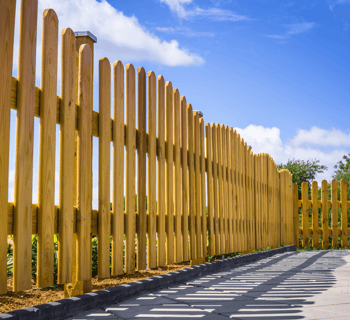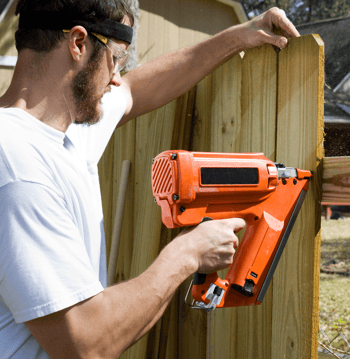 Fencing all or part of your property can add charm and style while giving you some extra privacy. Whether you make it into a do-it-yourself project or hire a contractor, there are a few steps you'll need to take first.
Fencing all or part of your property can add charm and style while giving you some extra privacy. Whether you make it into a do-it-yourself project or hire a contractor, there are a few steps you'll need to take first.
To get set up, check the zoning guidelines and get a permit if one is needed. Make sure you're aware of city easements on your property and where your property line is. Once you've completed this preparation, you can decide whether your new fence will be a do-it-yourself project or a contracted job.
 Know the Zoning Laws
Know the Zoning Laws
Check the zoning laws and the covenants and restrictions for your neighbourhood. Before you set your heart on a certain type of fencing, it's important to check and make sure it's allowed in your city and your neighbourhood. Some communities don't allow chain-link fencing for example. Or there may be requirements like a height restriction or limits on the types of materials used. When you submit your application to the city, you may need to add a letter from your homeowner's association. This letter will state that your proposed fence meets the guidelines for the community in which you live.
Get Your Permits in Place
Next, make sure that you have the right permit for putting up your fence. You'll want to make sure that it complies with city codes. Even though a homeowner doesn't have to obtain a building permit to construct a fence on a residential property, an application should be submitted with a site plan for the fence. This is a benefit to you, the property owner, because the plans examiner will make sure the fence is going to be built properly and safely.
You can check with the City of Calgary for the maximum height allowable for your fence and other requirements. There are different limits depending on whether the fence will be at the front or back of the house or at a corner where visibility is an issue. It's better to be informed than be forced to put up a fence twice because of some type of restriction.
If you hire a contractor to do the work, make sure that they are licensed, bonded, and have the proper permits. The homeowner is responsible for the absence of a permit even when using a contractor to do the work.
Ease Your Mind of Easements
Most properties have a small portion of the lot set aside as a city right of way, usually so that city workers can access electrical, plumbing, phone, and cable lines. Sometimes these reserved spaces are used as drainage areas.
To find out where the easements are in your yard, call Alberta One Call. Even though an easement is located on your property, it's still considered city property and you must follow city regulations when putting up your fence.
Know Your Property Line
Knowing where your property ends is an important part of installing a fence. For one thing, if a fence is along a property line, it's the responsibility of both neighbours to keep it up. That's why a discussion with the adjacent property owners needs to be part of the plan. If you decide to build your fence away from the property line, that's when it's especially important to check your easements and make sure you're not encroaching on city property.
Your Fence Preferences
Once you have all this prep work out of the way, your project becomes more enjoyable. Now you can start to think about what kind of materials you want to use and clarify your goals for installing a new fence. Is it for privacy or noise control? Or do you need fencing primarily to keep small children and pets safe? This will help you determine the details of what kind of fence you need.
Look around your neighbourhood at the fences already in place. This is a way to find fencing you like and see what it looks like before installation. It's also an opportunity to talk to your neighbours and get their input on which materials are more durable or easily maintained.
Pick Out a Particular Style
You'll want to carefully consider how the fence will complement your home. This involves the material used, the colour, and the type of fencing. You may opt to use one type of material for the rear fence and another for the front yard. Although wood is aesthetically pleasing, it does need regular maintenance. Some vinyl fencing is almost indistinguishable from wood and stands up better in the cold and snow.
 Hire the Right Contractor
Hire the Right Contractor
If you decide to hire a professional to install the fence for you, make sure you check them out before giving a deposit on the work. The fence company should have a licence and provide you with a contract for the work that includes the price, the timeline for finishing the job, a simple map of the property, and where the fence will be installed. The type of material agreed upon and the payment schedule should also be listed here.
Make Sure It's Affordable
Then there's the balance between the look you want and the type of fencing you can afford. Keep in mind the lifespan of the type of fence you choose and the amount of maintenance it will require. For example, wrought iron is almost maintenance-free but it's one of the most expensive types of fencing.
Remember that you'll need a gate wide enough for anything that you may want to bring into the yard. Some homeowners deal with this issue by installing a double gate and using only one side unless they need to move something large into the yard.
You may also consider asking your builder about landscaping to see if you can arrange for fencing to be included with the construction of your new home. It's a great idea to polish off your landscaping to have the nicest yard on your street with a complementary fence.
Enjoy Your New Fence
It's worth it to take the time to get set up properly and find the right kind of materials for your fence. Fencing is not only useful, but it can add to the curbside appeal of your home. Outdoor entertaining is easy and you can enjoy your outdoor living space all the more within the privacy and security of your attractive new fence!





